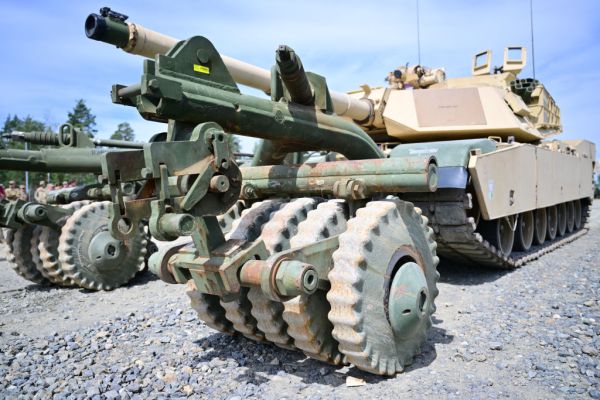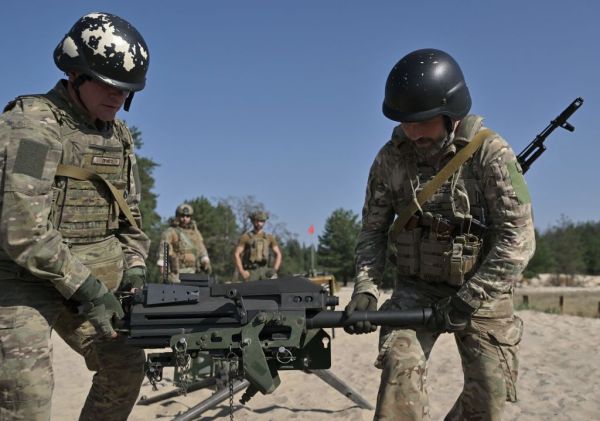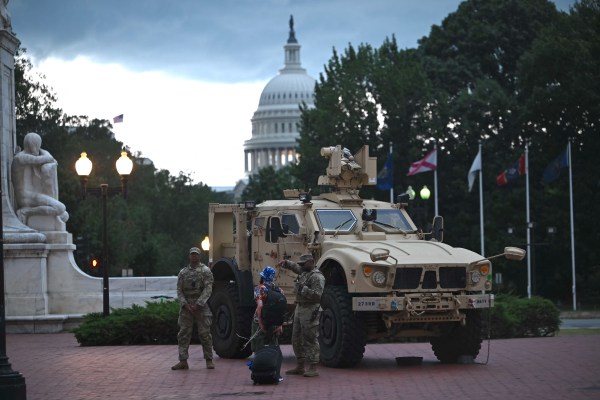Is the U.S. military merely a marginal force? If you based your answer on The Heritage Foundation’s latest Index of U.S. Military Strength, you might be tempted to think our armed forces are in disarray. But since 2015, the Index has served less as a strategic look at American security and more as a crude tool to promote slanted media coverage. This year is no different.
The overall structure of the Index is designed to project an impression of weakness. The report generally consists of around 600 pages of dense prose, often featuring a series of media-friendly charts rating the level of “Threats to U.S. Vital Interests” (from severe to low) and “U.S. Military Power” by service branch (from very weak to very strong). The problem, however, is that both scales are tilted to produce the intended result. Since 2018—the earliest report with a working hyperlink at Heritage’s website—the overall threat to American interests has never been anything but “high” (the second highest category). Only one threat category, “Af-Pak Terrorism,” has ever been rated as merely “elevated” (the middle category).
Likewise, the military power chart in the Index presents a loaded vision. The middle category labeled “marginal” is so scrupulous that even a service branch that meets the high standards Heritage sets for them can be blasted in headlines rather than being more accurately described as “sufficient” or “adequate.” Like the threats chart, Heritage has not rated any service branch as “very strong” since 2018, and the overall rating has never been higher than “marginal”—a strange state of affairs for the world’s strongest military.
Underlying these slanted assessments is an astoundingly inconsistent analysis. One might assume, for instance, that all of the service branches would be judged by the same standards. They aren’t. The report purports to measure each branch against a “two major regional contingency” (2MRC) standard, or the ability to handle two major wars simultaneously. Yet the Marine Corps—the only branch to get a “strong” rating this year—was judged against a single contingency standard, which contributed to its higher rating. Moreover, ratings of capacity, capability, and readiness for each branch reveal more inconsistencies. The Army and the U.S. nuclear arsenal are rounded down to produce their marginal rating; meanwhile, the Marine Corps is rounded up to produce its strong rating. Even more baffling, the Air Force—the lowest rated (“very weak”) service in the report—isn’t rounded at all. Rather, the Index just glibly declares that “success or failure is determined by the weakest leg,” essentially rating the Air Force based on its weakest category.
The Air Force’s “very weak” ranking reveals further issues with the Index. The branch’s rating is based on several factors, but the ones mentioned explicitly in the report summary are the supposedly “incredibly low sortie rates and flying hours.” Incredibly low compared to what? Given the 2MRC standard, the answer has to be pilot training compared to America’s top two adversaries, China and Russia. Yet the Index cherry-picks its figures, drawing flight time numbers from during the COVID-19 pandemic to complain that mission-ready fighter pilots received only 131 hours of flying time per year and arguing that such low figures put the Air Force at risk of falling behind peer adversaries. Though the Air Force itself has expressed concerns about declining time in the cockpit, American fighter pilots still average far more flight time than our adversaries—100 hours more compared to China’s Air Force, for example.
Indeed, when assessing Chinese military capacity generally, it’s important to remember that effectively none of China’s officers, soldiers, or modern systems have been tested in combat. By contrast, functionally all of America’s systems and many of its officers and soldiers have been tested—and have passed that test.
The lack of a meaningful measure to compare the U.S. military to that of our adversaries plagues the entire Index. Dramatically, the report judges America’s nuclear arsenal as merely “marginal,” despite the country’s current roughly 3,000 nuclear warheads. One struggles to think of a situation in which that stockpile would be insufficient (to say nothing of how too large a force carries risks of its own).
The Index also glaringly overlooks Russia’s war against Ukraine in its assessment. The Kremlin’s full-scale invasion exposed the shocking weakness of the second-strongest American adversary and the destruction of much of its equipment and personnel. Yet these factors seem to have had no effect on America’s comparative strength according to the Index. Likewise, China’s economic woes have cast significant doubt on Beijing’s ability to build its military capacity indefinitely. There isn’t a hint of this weakness in the Index’s headline ratings either.
None of this suggests the U.S. lacks security challenges. The Index is hardly alone in sounding the alarm about how decades of continued procurement debacles and declining shipbuilding capability have left the U.S. Navy without needed ships. For instance, consider the new Constellation-class frigate. Originally intended to save on costs by simply borrowing the design of the existing Franco-Italian FREMM-class, the Navy has squandered this cost advantage by redesigning nearly every aspect of the ship, leading the project to run substantially over budget. This is worth criticizing.
But the Index doesn’t address this problem at all. Instead, it merely calls for more funding to produce a battle force of 400 manned ships without engaging with the issue that, as Navy procurement stands today, no amount of money appears capable of teaching it how to build ships. Some problems cannot be solved by merely calling for more cash.
It’s not particularly hard to detect a probable political agenda for the report, which also decries “Department of Defense officials who pursue a woke agenda.” Presenting the report, Fox & Friends co-hosts Brian Kilmeade and Pete Hegseth seem to have understood the point perfectly well. They blamed DEI for the poor (manufactured) ratings, claiming that the military “Bud Light-ed itself, looking for a new constituency,” referring to the anti-trans Bud Light boycotts from last year. What neither Heritage nor the TV personalities mentioned, however, was that armies that tolerate or reinforce deep social or political inequalities perform poorly on the battlefield. Therefore, the U.S. military’s concern with addressing such inequalities speaks to real concerns over military performance; it is Heritage and its allies who are playing identity politics with our security.
Strategy is fundamentally the art of assigning priorities and making tradeoffs, matching limited resources to limitless interests and threats. But precisely because the Index always seeks to find American military weakness, it is incapable of engaging in questions of priorities and tradeoffs. Put another way, the report fails at the difficult but essential task of strategy-making.
Consider the 2MRC standard again. It might seem wise to demand the United States maintain the forces necessary to deal with two major regional contingencies, without major mobilizations or conscription, given the aggressiveness of China and Russia. But the 2MRC standard, introduced in 1993 and abandoned in 2012, was always deeply flawed. While the modern 2MRC standard evokes the British two-power standard, adopted in 1889, of maintaining a navy stronger than the next two largest navies, the two-power standard was an exercise in prioritization, rating the Royal Navy and maritime security over other concerns, like having a strong army. Heritage’s 2MRC vision, on the other hand, stretches across all domains and all theaters, abandoning the all-important question of priorities. If all threats are equally important, then none of them are.
Likewise, the decision to simply pour more money into the military avoids difficult tradeoffs. After all, money must be found somewhere. It would be plausible, if politically toxic, to argue that in a more dangerous world Americans must be willing to accept higher taxes and fewer government services in order to spend more on security. Yet Heritage insists its 2MRC plan is consistent with large tax cuts. But Heritage isn’t willing to see the spending financed with government debt, nor does it endorse serious entitlement cuts. Instead, it merely proposes, that entitlements be made “sustainable.” Though the Index prefaces its discussion of the defense budget by claiming that “the goal is not to give a definitive answer,” it feels like it safely defers the important, hard questions to others.
Defense spending is undoubtedly necessary. But as Dwight D. Eisenhower declared in 1953, “Every gun that is made, every warship launched, every rocket fired signifies, in the final sense, a theft from those who hunger and are not fed, those who are cold and are not clothed.” Americans will need to engage in contentious debates over how to balance guns and butter, but the Index is not designed for this. It is designed as a bullhorn for greater military spending that ignores strategic priorities or the present weaknesses of our adversaries. It is a cudgel with which Heritage can fight its progressive enemies by hammering American defense policy into yet another front in the culture war. But it is not the serious, strategic analysis that the United States needs to face the dangers of our world.









Please note that we at The Dispatch hold ourselves, our work, and our commenters to a higher standard than other places on the internet. We welcome comments that foster genuine debate or discussion—including comments critical of us or our work—but responses that include ad hominem attacks on fellow Dispatch members or are intended to stoke fear and anger may be moderated.
With your membership, you only have the ability to comment on The Morning Dispatch articles. Consider upgrading to join the conversation everywhere.